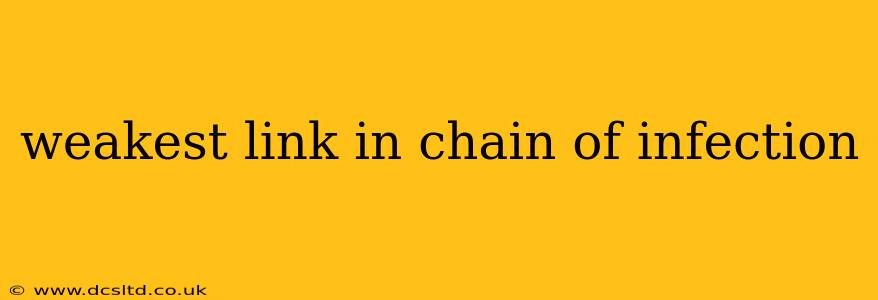The chain of infection is a crucial concept in epidemiology and infection control. Understanding this chain—which outlines the steps required for an infection to spread—is vital for preventing and controlling the spread of infectious diseases. It’s often depicted as a series of links, and breaking any of these links effectively halts the transmission process. But the question remains: which link is the easiest, or most effective, to target for intervention? While there isn't one single universally "weakest" link, focusing on certain points offers the most significant impact. This article explores the chain of infection and highlights the most impactful points of intervention.
The Chain of Infection: A Detailed Look
The chain of infection typically consists of six links:
-
Infectious Agent: This is the pathogen (bacteria, virus, fungus, parasite, or prion) causing the disease. Factors like its virulence (ability to cause disease) and the dose (amount of the pathogen) play a significant role.
-
Reservoir: This is the place where the infectious agent lives and multiplies. This can be a human (e.g., a person with an active infection), an animal, or the environment (e.g., contaminated water or soil).
-
Portal of Exit: This is how the infectious agent leaves the reservoir. Examples include respiratory secretions (coughing, sneezing), feces, blood, urine, or open wounds.
-
Mode of Transmission: This is how the infectious agent travels from the reservoir to a susceptible host. Modes include direct contact (e.g., touching an infected person), indirect contact (e.g., touching a contaminated surface), airborne transmission (e.g., inhaling droplets), vector-borne transmission (e.g., mosquito bite), and vehicle-borne transmission (e.g., contaminated food or water).
-
Portal of Entry: This is how the infectious agent enters a new host. It's often the same as the portal of exit (e.g., inhalation, ingestion, or contact with mucous membranes).
-
Susceptible Host: This is a person who is at risk of infection because their immune system is compromised or they lack immunity to the specific infectious agent. Factors such as age, underlying health conditions, and vaccination status affect susceptibility.
Which Link is the Easiest to Break? The Case for Hand Hygiene and Infection Control
While each link is critical, targeting mode of transmission and portal of entry offers the most readily accessible points of intervention for infection control in most settings. This often translates into focusing on hand hygiene and other infection control measures.
Why hand hygiene is crucial: Effective handwashing with soap and water, or the use of an alcohol-based hand rub, interrupts the chain of infection by significantly reducing the spread of pathogens through direct and indirect contact. This simple act effectively addresses a wide range of transmission modes. It’s a cost-effective and readily accessible intervention with a huge impact.
Other important points of intervention:
- Proper sterilization and disinfection: This directly addresses the infectious agent and its potential to spread via contaminated surfaces or equipment.
- Vaccination: This strengthens the susceptible host by creating immunity against specific infectious agents.
- Environmental sanitation: This targets the reservoir and reduces the opportunity for pathogen survival and transmission.
- Isolation and quarantine procedures: This limits the spread of infection by preventing contact between infected individuals and susceptible hosts.
Frequently Asked Questions
What is the most important link in the chain of infection?
There isn't one single "most important" link. Each link is essential for infection to occur. However, targeting the mode of transmission (e.g., through hand hygiene and environmental sanitation) often offers the most impactful strategy.
Can you give examples of breaking each link in the chain of infection?
- Infectious Agent: Antimicrobial drugs target and eliminate the infectious agent.
- Reservoir: Controlling rodent populations eliminates reservoirs for certain diseases.
- Portal of Exit: Proper wound care prevents pathogens from exiting the body.
- Mode of Transmission: Handwashing prevents the spread of pathogens.
- Portal of Entry: Wearing protective equipment (e.g., masks, gloves) prevents pathogens from entering the body.
- Susceptible Host: Vaccination increases the host's resistance to infection.
How can I protect myself from infection?
Practicing good hygiene (handwashing, showering regularly), getting vaccinated, and following safe food handling practices are excellent ways to protect yourself. Avoid contact with infected individuals when possible, and be aware of your surroundings to minimize risk exposure.
By understanding the chain of infection and focusing on the most readily accessible points of intervention, we can significantly reduce the spread of infectious diseases and protect public health. While pinpointing the single "weakest" link is challenging, prioritizing strategies like hand hygiene, proper disinfection, and vaccination offers the most significant and impactful results in disrupting the cycle of disease transmission.
